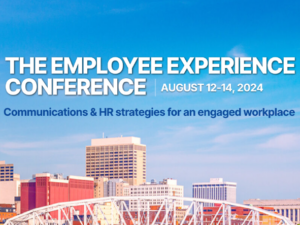Navigating the barriers between effective internal comms and an engaged workforce
Executives navigating the increasingly complicated world of internal communications face multiple pain points ranging from organizational structure to the composition of the workforce.

Dan Ekstein has more than two decades of corporate communications and business advocacy experience, providing trusted counsel to senior communications, external affairs, and government affairs executives.
Ideas may be the currency of the twenty-first century, as Carmine Gallo writes in the Harvard Business Review. Yet, “the ability to persuade, to change hearts and minds, is perhaps the single greatest skill that will give you a competitive edge in the knowledge economy,” he notes.
Not only are persuasive skills the hallmark of successful salespeople, but they are crucial for internal communicators as well. After all, internal communications is the thread that connects an organization’s mission and strategy to employee engagement and performance. Research shows that employees perform at their best when they’re engaged with their company and aligned with the mission. According to Gallup, engaged employees have higher productivity and are more likely to stay with a company.
So, what stands between effective internal comms and an engaged, productive workforce? Executives navigating the increasingly complicated world of internal communications face multiple pain points ranging from organizational structure to the composition of the workforce.
Let’s start with the corporate hierarchy. At the top of the pyramid, senior executives set the business strategy and ensure it is accomplished. Forming the base are the rank-and-file employees who keep the company running. Caught between these two powerful forces is the sandwich generation of corporate America: the mid-level managers who are receiving information from the top and disseminating it to the layers below – all while managing their teams and pursuing their own corporate goals.
The landscape is further complicated by changes in the workplace itself. More than half (58%) of U.S. jobholders surveyed by McKinsey have the option of working from home on a part-time or full-time basis, while 41% say they must be onsite. Internal communications must engage all of them, whether they’re taking a break from the production line, or working from their kitchen counter.
Taking a close look at the workers themselves gives us additional insight into the complexity internal comms faces. According to a U.S. Bureau of Labor Statistics estimate cited by Fortune, a quarter of the workforce will be over 55 by 2024. And as the workforce ages, multigenerational teams are on the rise.
Interaction between Gen Z, Millennials, Gen X and Boomers has demonstrated benefits. AARP tells us that “mixed-age teams make better business decisions 87% of the time than teams without age diversity.” However, it’s essential to remember that the different generations have different goals and work styles. For example, they consume information in different ways. Older workers may happily participate in Town Halls; meanwhile, Gen Z is checking their phone for text updates.
An effective internal comms strategy must take these major dynamics into account. Here are four things to consider as you ponder your internal communications strategies.
One size does not fit all. First off, do you recognize your situation in the above scenarios? If yes, consider how you are addressing internal communications beyond the business unit – and how you are tailoring your messaging to your different constituencies. While your core message should remain the same, one-size does not fit all when it comes to communications. You’ve got to meet employees where they are and consider their goals and what motivates them. For example, almost half (48%) of Gen Z workers say their attitude at work is primarily focused on getting the job done, while close to a third (31%) of Boomer workers say a feeling of purpose from their work has kept them in their current job, the Wall Street Journal reports.
It’s never too late for a reality check. If you don’t recognize your situation, it may be time for a comms audit to ensure that your messaging finds its intended targets and prompts the desired behavior.
Lean into the complexity. Complexity in the workplace isn’t going away any time soon. Embrace multi-generational teams and the benefits they can bring.
Use the right tools. Are your employees actually receiving your messages? An employee who relies on Teams, for instance, may skip over blast emails in their inbox. Be sure to leverage different communications channels from in-person meetings and Town Halls to messaging platforms and apps and tailor them to your audiences. It’s also important that your tools – be they written or verbal – and policies help all employees communicate comfortably regardless of the platform, the U.S. Chamber of Commerce recommends.
And remember, while there is a plethora of communications tools, from Teams to Slack to Zoom, tools are only part of the solution. At the end of the day, it’s the power of human interaction and persuasive communication that will drive the success of your strategy.
Dan founded Tentpole Strategies to help companies empower their internal communications and employee engagement strategies and campaigns. He is also Partner and Chief Business Development Officer at Sagac Public Affairs. Connect with Tentpole Strategies on LinkedIn, Instagram and Facebook.






